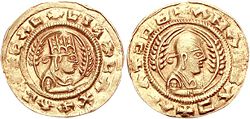Kingdom of Aksum
The Kingdom of Aksum (Ge'ez: መንግስቲ ኣኽሱም), also known as the Kingdom of Axum or the Aksumite Empire, was an ancient kingdom centered in what is now Eritrea and the Tigray Region of northern Ethiopia.[2][3] Axumite Emperors were powerful sovereigns, styling themselves King of kings, king of Aksum, Himyar, Raydan, Saba, Salhen, Tsiyamo, Beja and of Kush.[4] Ruled by the Aksumites, it existed from approximately 80 BC to AD 825.[5] It was centered in the city of Axum and grew from the proto-Aksumite Iron Age period around the 4th century BC. It became important by the 1st century AD. Aksum became a major player on the commercial route between the Roman Empire and Ancient India. The Aksumite rulers made trade easier by minting their own Aksumite currency. The state also assumed its hegemony over the declining Kingdom of Kush. It also regularly entered the politics of the kingdoms on the Arabian Peninsula and eventually extended its rule over the region with the conquest of the Himyarite Kingdom. The Manichaei prophet Mani (died 274 AD) regarded Axum as one of the four great powers of his time; the others were Persia, Rome, and China.[2][6][7] [8]
Aksumite Empire መንግስቲ ኣኽሱም (Ge'ez) | |||||||||||||||||||
|---|---|---|---|---|---|---|---|---|---|---|---|---|---|---|---|---|---|---|---|
| c. 100 AD – c. 940 AD | |||||||||||||||||||
Aksumite currency depicting King Endubis
| |||||||||||||||||||
 All territories ever part of the Aksumite Empire | |||||||||||||||||||
| Capital | Aksum | ||||||||||||||||||
| Common languages | Ge'ez | ||||||||||||||||||
| Religion | Arabian polytheism (pre-Aksumite to 4th century) Judaism (before c. 330) Christianity (Ethiopian Orthodox Tewahedo Church; after c. 330) | ||||||||||||||||||
| Government | Monarchy | ||||||||||||||||||
| Negūs | |||||||||||||||||||
• c. 100 | Za Haqala (first known) | ||||||||||||||||||
• c. 940 | Dil Na'od (last) | ||||||||||||||||||
| Historical era | Classical Antiquity to Early Middle Ages | ||||||||||||||||||
• Established | c. 100 AD | ||||||||||||||||||
• Conquest by Gudit | c. 960 AD | ||||||||||||||||||
| Area | |||||||||||||||||||
| 350[1] | 1,250,000 km2 (480,000 sq mi) | ||||||||||||||||||
| Currency | AU, AR, AE units | ||||||||||||||||||
| |||||||||||||||||||
| Today part of | Eritrea Ethiopia Djibouti Somalia Yemen Sudan Saudi Arabia Egypt | ||||||||||||||||||
The Aksumites built monumental stelae, which served a religious purpose in pre-Christian times. One of these granite columns is the largest such structure in the world, at 90 feet.[9] Under Ezana (fl. 320–360) Aksum adopted Christianity. In the 7th century, early Muslims from Mecca sought refuge from Quraysh persecution by travelling to the kingdom, a journey known in Islamic history as the First Hijra.[10][11]
The kingdom's ancient capital, also called Axum, is now a town in Tigray Region (northern Ethiopia). The Kingdom used the name "Ethiopia" as early as the 4th century.[12][13] Tradition claims Axum as the alleged resting place of the Ark of the Covenant and the purported home of the Queen of Sheba.[14]
References
change- ↑ Turchin, Peter and Jonathan M. Adams and Thomas D. Hall: "East-West Orientation of Historical Empires and Modern States", p. 222. Journal of World-Systems Research, Vol. XII, No. II, 2006
- ↑ 2.0 2.1 The wealth of Africa – The kingdom of Aksum – Teachers’ notes Archived 2017-05-17 at the Wayback Machine britishmuseum.org
- ↑ Butzer, Karl W. (1981). "Rise and Fall of Axum, Ethiopia: A Geo-Archaeological Interpretation". American Antiquity. 46 (3). Cambridge University Press: 471–495. doi:10.2307/280596. JSTOR 280596. S2CID 162374800.
- ↑ Dr. Stuart Munro-Hay, [1] Aksum: An African Civilisation of Late Antiquity. Chap. 11, Inscription DAE 8
- ↑ Hunt, Katie (11 December 2019). "Archeologists unearth lost town from little-known ancient East African empire". CNN. Retrieved 2019-12-12.
- ↑ Daily Life in Aksum Archived 2017-05-16 at the Wayback Machine eduplace.com
- ↑ Marshall, Michael. "Lost Ethiopian town comes from an ancient empire that rivalled Rome". New Scientist. Retrieved 2019-12-10.
- ↑ Harrower, Michael J.; Dumitru, Ioana A.; Perlingieri, Cinzia; Nathan, Smiti; Zerue, Kifle; Lamont, Jessica L.; Bausi, Alessandro; Swerida, Jennifer L.; Bongers, Jacob L.; Woldekiros, Helina S.; Poolman, Laurel A. (December 2019). "Beta Samati: discovery and excavation of an Aksumite town". Antiquity. 93 (372): 1534–1552. doi:10.15184/aqy.2019.84. ISSN 0003-598X. S2CID 213311047.
- ↑ Brockman, Norbert (2011). Encyclopedia of Sacred Places, Volume 1. ABC-CLIO. p. 30. ISBN 978-1598846546.
- ↑ "Archived copy" (PDF). Archived from the original (PDF) on 2017-01-07. Retrieved 2017-01-06.
{{cite web}}: CS1 maint: archived copy as title (link) - ↑ "GoBlues - Asheville School" (PDF).
- ↑ Munro-Hay, Stuart (1991). Aksum: An African Civilization of Late Antiquity (PDF). Edinburgh: University Press. p. 57. Archived from the original (PDF) on January 23, 2013. Retrieved February 1, 2013.
- ↑ Paul B. Henze, Layers of Time: A History of Ethiopia, 2005.
- ↑ Raffaele, Paul (December 2007). "Keepers of the Lost Ark?". Smithsonian Magazine. Retrieved 5 April 2011.
